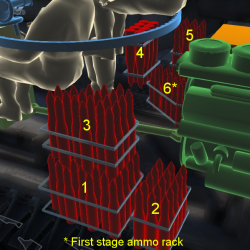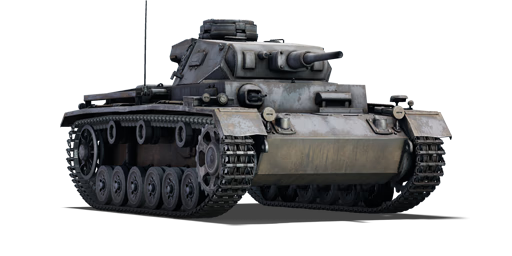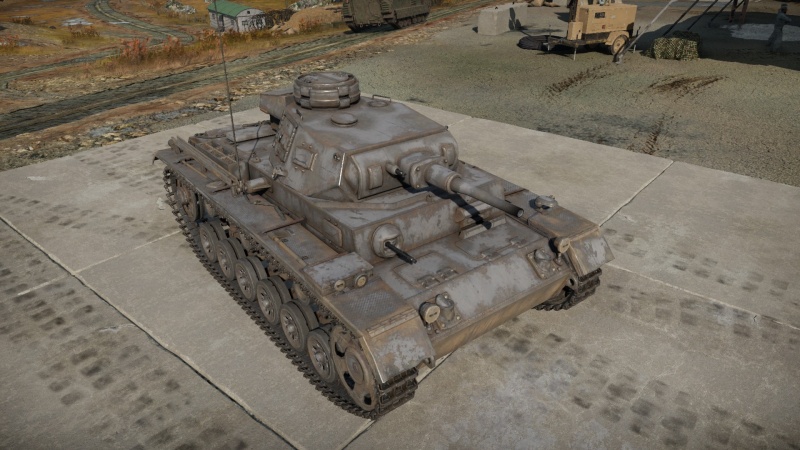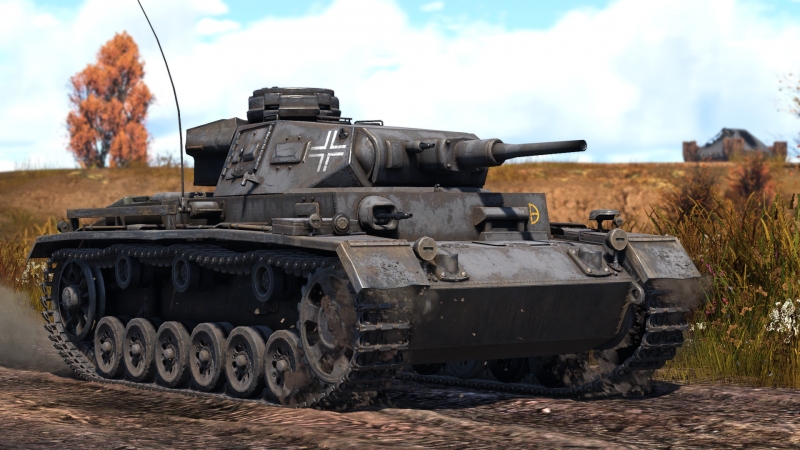Pz.III J
| This page is about the German medium tank Pz.III J. For other versions, see Panzer III (Family). |
Contents
Description
The Panzerkampfwagen III Ausführung J (Panzer III J) (Sd.Kfz. Index: Sd.Kfz. 141) is the ninth variant of the Panzerkampfwagen III medium tank family (the "I" variant was skipped). The Panzer III J looked much like the Panzer III G. It was designed with a turret housing a 50 mm Kampfwagenkanone (KwK) 38 L/42 tank gun. It used the same Maybach HL 120 TRM petrol/gasoline 285 horsepower engine and had identical armour thickness. The hull frontal armour's basic armour thickness had increased to 50 mm. An additional armour plate was installed internally to the front of the turret in the spring of 1941, increasing it to a maximum thickness of 57 mm in places. To improve engine compartment ventilation, the structure of the chassis was extended. The armoured front brake vents were redesigned. On the roof of the turret was an armoured extractor fan. The 50 mm KwK38 L/42 tank gun was capable of firing up to 20 rounds per minute, through the use of a semi-automatic breech that opened before the end of the recoil, ejected the used casing, and allowed for fast loading of the next shell.
Introduced in Update 1.45 "Steel Generals", the Panzer III J is the next addition to the Panzer III medium tank family. The Panzer III J, armed with the already familiar 50 mm KwK38 L/42 tank gun, can readily deal with adversaries in its ranks. Increased hull frontal armour thickness allows players to take greater risks during combat. The turret traverse, on the other hand, is sluggish, owing to the lack of an electric power traverse system. This is arguably one of the most significant disadvantages of any Panzer IIIs, especially when fighting in towns or areas with a lot of cover. Players must use caution when playing in maps where enemy tanks might quickly set up ambush.
General info
Survivability and armour
Armour type:
- Rolled homogeneous armour
- Cast homogeneous armour (Barrel shroud, Cupola)
| Armour | Front | Sides | Rear | Roof |
|---|---|---|---|---|
| Hull | 50 mm (12°) Front plate 25 mm (86°), 50 mm (52°) Front glacis 50 mm (23-69°) Lower glacis |
30 mm | 50 mm (14-46°) Top 50 mm (10-66°) Bottom |
15 mm |
| Turret | 50 mm (10-25°) Turret front 50 mm (12-62°) Gun mantlet |
30 mm (20-25°) | 30 mm (12-15°) | 10 mm |
| Cupola | 50 mm (spherical) | 10 mm | ||
Notes:
- Suspension wheels are 15 mm thick while tracks are 20 mm thick.
Mobility
| Game Mode | Max Speed (km/h) | Weight (tons) | Engine power (horsepower) | Power-to-weight ratio (hp/ton) | |||
|---|---|---|---|---|---|---|---|
| Forward | Reverse | Stock | Upgraded | Stock | Upgraded | ||
| Arcade | 60 | 12 | 21.8 | 465 | 572 | 21.33 | 26.24 |
| Realistic | 54 | 10 | 265 | 300 | 12.16 | 13.76 | |
Modifications and economy
Armaments
Main armament
| 50 mm KwK L/42 | Turret rotation speed (°/s) | Reloading rate (seconds) | |||||||||||
|---|---|---|---|---|---|---|---|---|---|---|---|---|---|
| Mode | Capacity | Vertical | Horizontal | Stabilizer | Stock | Upgraded | Full | Expert | Aced | Stock | Full | Expert | Aced |
| Arcade | 99 | -10°/+20° | ±180° | N/A | 5.2 | 7.2 | 8.8 | 9.7 | 10.4 | 5.20 | 4.60 | 4.24 | 4.00 |
| Realistic | 3.3 | 3.8 | 4.7 | 5.2 | 5.5 | ||||||||
Ammunition
| Penetration statistics | |||||||
|---|---|---|---|---|---|---|---|
| Ammunition | Type of warhead |
Penetration @ 0° Angle of Attack (mm) | |||||
| 10 m | 100 m | 500 m | 1,000 m | 1,500 m | 2,000 m | ||
| PzGr 39 | APC | 80 | 76 | 62 | 48 | 38 | 29 |
| PzGr 40 | APCR | 116 | 107 | 74 | 47 | 30 | 19 |
| Shell details | ||||||||||||
|---|---|---|---|---|---|---|---|---|---|---|---|---|
| Ammunition | Type of warhead |
Velocity (m/s) |
Projectile mass (kg) |
Fuse delay (m) |
Fuse sensitivity (mm) |
Explosive mass (TNT equivalent) (g) |
Ricochet | |||||
| 0% | 50% | 100% | ||||||||||
| PzGr 39 | APC | 685 | 2.05 | 1.2 | 9 | 28.9 | 48° | 63° | 71° | |||
| PzGr 40 | APCR | 1,050 | 0.9 | - | - | - | 66° | 70° | 72° | |||
Ammo racks

| Full ammo |
1st rack empty |
2nd rack empty |
3rd rack empty |
4th rack empty |
5th rack empty |
6th rack empty |
Visual discrepancy |
|---|---|---|---|---|---|---|---|
| 99 | 78 (+21) | 63 (+36) | 43 (+56) | 35 (+64) | 23 (+76) | 1 (+98) | No |
Notes:
- Shells are individually modeled.
- Ready rack only: 23 (+76) shells.
Machine guns
| 7.92 mm MG34 | ||||
|---|---|---|---|---|
| Mount | Capacity (Belt) | Fire rate | Vertical | Horizontal |
| Coaxial | 4,350 (150) | 900 | N/A | N/A |
The small calibre of the MG34 machine gun makes it largely ineffective against all armoured vehicles but the ones with an open compartment. It still can be used to ping targets as a rangefinding help or to mow down minor obstacles blocking your line of sight.
Usage in battles
Use of this tank is similar to the Pz.III F, and while it does have significantly better armour on the front than its predecessor, the higher BR means it faces nastier opposition. T-34 (1940)s are almost impenetrable from any side except flat-on below the tracks. M4A1s are similar in speed to you, have thinner sides, are spacious, have powerful guns, and stabilizers. Cromwells are much faster than you with stronger guns. You can only hope for them to get overconfident, overextend, and shoot them in the side or rear. APCR post-penetration damage is not reliable enough to be counted upon when you need it the most, and often can't frontally penetrate a Sherman or T-34 anyway.
Furthermore, even in the best circumstances, the high fuse sensitivity makes many lightly-armoured things with strong guns your worst nightmare, since you'll over-penetrate repeatedly in most cases, allowing easy return fire from the person you failed to knock out, which more often than not cripples you. Enemy SPAAGs, in particular, are frustrating to knock out because of your 15 mm turret ring weak spot enabling them to spray all over you to incapacitate your gunner and loader.
Pros and cons
Pros:
- Accurate and decently powerful gun
- Good gun depression
- Good mobility
- APCR ammo has very high speed and good penetration, making shooting at long-range easier
- Armour is fairly decent and can protect reliably against lower-calibre guns
Cons:
- Average to low armour penetration with regular ammunition
- Poor turret traverse speed
- Flat armour with little slope, thin side armour
- Large commander's cupola which can stick out above the terrain and receive fire
- Rather high shell fuse sensitivity relative to the cannon's power
History
Development
The Panzerkampfwagen III medium tank or the Panzer III was developed in the 1930s. Starting in early 1934, Heinz Guderian set down some specifications for a new tank, which Army Weapons Department took up to design the tank to weigh no more than 24,000 kilograms with a top speed of 35 km per hour. This tank's role was to be the main tank of the German army and was expected to destroy opposing tanks, as opposed to a tank made to destroy anti-tank guns and opposing infantrymen, which the Panzer IV took up in.
Daimler-Benz, Krupp, MAN, and Rheinmetall produced prototypes meeting the specifications and the Daimler-Benz model was chosen after testing in 1936-1937. The Panzer III model used a leaf-spring suspension in its early models (Ausf. A - Ausf. D) before utilizing a six-wheeled torsion-bar suspension in the Ausf. E and beyond. The Panzer III had a crew of five people, the commander, gunner, loader, driver, and assistant driver. The best feature of the Panzer III during its introduction that is the most overlooked was the three-man turret, which was not as common at the time. This frees the commander to be able to effectively command the tank while maintaining situational awareness rather than be burdened by the role of a loader or gunner, improving the combat effectiveness of the tank. Despite this rather advanced design, the turret did not have a turret basket for the crew. It was a proven design and production began in May 1937. The total number of Panzer IIIs tanks constructed in its production life was 5,774 units (excluding StuG III variant).
Specifications
The Panzer III started with only 15 mm of armour on all sides, this was quickly upgraded to 30 mm on the front, side, and rear on the Ausf. D, E, F, and G models. Then the Ausf. H placed an additional 30 mm of armour onto the front hull as an interim solution before the Panzer III Ausf. J gave the Panzer III a 50 mm armour thickness on the front and rear. The Panzer III Ausf. J still retained the 50 mm KwK 38 cannon from the Ausf. F, which provided much-needed firepower over the 37 mm KwK 36. The Panzer Ausf. J had a 300 PS Maybach HL 120 TRM engine that gave it a top speed of about 40 km/h (25 mph) with an operational range of 155 km (96 mi.).
Combat usage
The Panzer III Ausf. J gave the German army better armour for their Panzer III and with a better gun. However, it was still considered under-gunned by the Soviet contemporary T-34 and KV-1 tanks as the 50 mm KwK 38 was not powerful enough to penetrate these tanks frontally with normal ammo. This requires the use of APCR, which was in low supply. The Soviet T-26 and BT series light tanks were still easily taken care of and they were still in larger quantities than the T-34s and KVs, but T-34 production was kicking off and it won't be long before the T-34 becomes the main tank of the Red Army.
The Panzer III still needed improvements if it ever was to go up against the more modern tanks and Germany needed it to stay in service as long as possible as their new tanks were being developed. The next variant featured additional armour and a better 50 mm cannon, the 50 mm KwK 39, on the Panzer III Ausf. J1. The armour had an additional 20 mm offset armour in the front hull and turret, plus the 50 mm KwK 39 featured a longer barrel than the 50 mm KwK 38, increasing its penetration values.
| Archive of the in-game description | |
|---|---|
|
One of the serial modifications to the Pz.Kpfw.III light tank, 1,549 of these tanks were produced from March to October 1941. The armour plating installed on tanks of the Ausf. H modification was a temporary measure. Tanks of the Pz.Kpfw.III Ausf. J modification began to be released in March 1941. The thickness of the single-layer, homogeneous armour of the front and rear plates was 50 mm. The design of the spherical machine gun installation had to be modified due to the increase in the thickness of the armour plates. A large number of less significant changes were also made. The first vehicles released were added to the arsenal of the African Corps, but the overwhelming majority entered divisions that were performing combat operations in the incipient war with the Soviet Union. Towards the middle to late stages of the war, the Soviet Union captured large numbers of German vehicles including Pz.III Ausf. Js and would put them into use against their former owners. | |
Media
- Skins
- Sights
- Videos
See also
Other vehicles of the Panzer III series:
Vehicles of similar configuration:
External links
| Germany medium tanks | |
|---|---|
| Pz.III | Pz.III B · Pz.III E · Pz.III F · Pz.III J · Pz.III J1 · Pz.III J1 TD · Pz.III L · Pz.III M · Pz.III N |
| Pz.IV | Pz.IV C · Pz.IV E · Pz.IV F1 · Pz.IV F2 · Pz.IV G · Pz.IV H · Pz.IV J · Pz.Bef.Wg.IV J |
| Pz.V | VK 3002 (M) · Panther A · Panther D · Panther F · Panther G · Ersatz M10 · Panther II |
| M48 upgrades | M48A2 G A2 · M48 Super |
| Leopard 1 | Leopard I · Leopard A1A1 · Leopard A1A1 (L/44) · Leopard 1A5 · C2A1 · Turm III |
| Leopard 2 | PT-16/T14 mod. · Leopard 2K · Leopard 2AV |
| Leopard 2A4 · Leopard 2 (PzBtl 123) · Leopard 2A4M · Leopard 2 PL · Leopard 2A5 · Leopard 2 PSO · Leopard 2A6 · Leopard 2A7V | |
| Trophies | ▀M4 748 (a) · ▀T 34 747 (r) |
| Other | Nb.Fz. · KPz-70 |
| USA | mKPz M47 G · M48A2 C |
| USSR | ◊T-72M1 |






